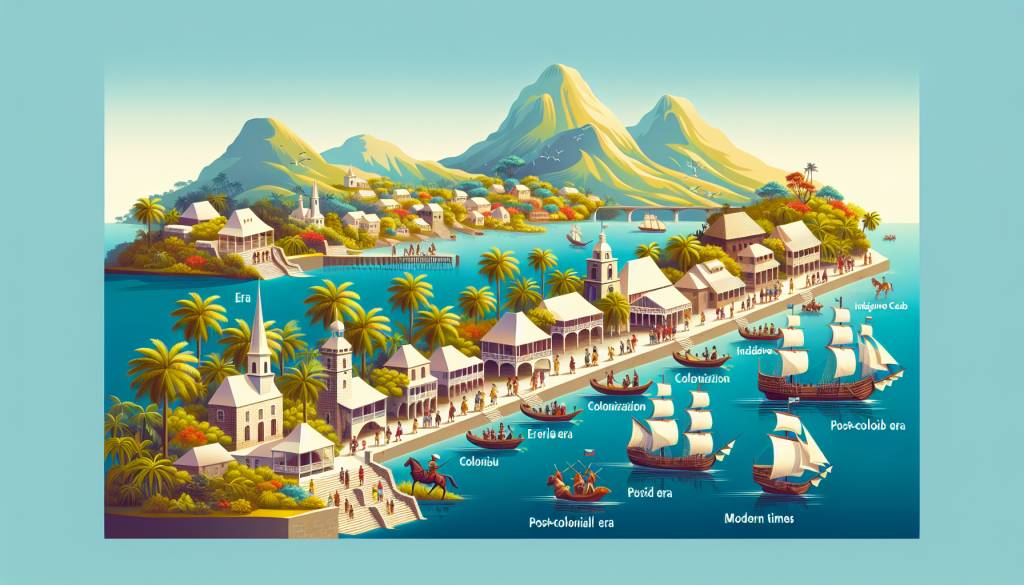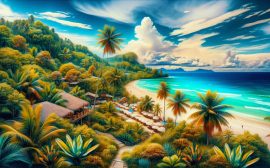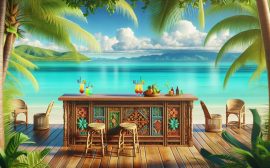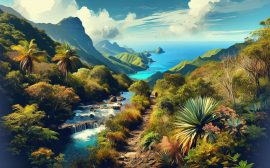An enchanting symphony of azure Caribbean waters, lush green landscapes, and a rich tapestry of cultural influences defines the island of Martinique. Yet, beneath its tropical allure lies a profound historical narrative waiting to be uncovered.
The Indigenous Beginnings
Long before Columbus set foot on its picturesque shores, Martinique was home to indigenous people known as the Arawaks and later the Caribs. These early inhabitants named the island « Madinina, » meaning « island of flowers » in the Carib tongue. Evidence of their habitation remains in petroglyphs, artefacts, and language imprints, telling stories of a life deeply connected to the land and sea.
European Arrival and Colonial Era
The annals of Martinique’s history turned a significant page in 1493 when Christopher Columbus sighted the island. However, it wasn’t until 1635, with the arrival of the French, that Martinique’s modern story began to unfold. The indigenous populations were decimated due to disease and conflict, and the French began to establish settlements, initiating the plantation economy that would define the island’s future.
The Sugarcane Chronicles
The cultivation of sugarcane became the backbone of Martinique’s economy. With it came the dark era of slavery, as African people were brutally transported to work on the plantations in inhumane conditions. The island’s prosperity in the 18th and 19th centuries was built on this exploitation, its remnants seen in historical structures and the enduring Creole culture.
Struggle for Freedom and Abolition of Slavery
The year 1848 marked a pivotal turn in Martinique’s timeline when slavery was abolished under French law. Victor Schoelcher, a prominent abolitionist, played a crucial role in this social and political transformation. The end of slavery led to a shift in labor dynamics, with the arrival of indentured servants from India and other parts of Asia, contributing further to the island’s multicultural character.
Volcanic Eruption of Mount Pelée
Disaster struck Martinique in 1902 when the volcanic Mount Pelée erupted, devastating the town of Saint-Pierre. Once known as the « Paris of the West Indies » and the island’s cultural capital, Saint-Pierre was virtually wiped off the map, with only a handful of survivors. This tragic event had a lasting impact on Martinique’s geographical and societal landscape.
The Path to Modernization
In the aftermath of the eruption, Fort-de-France rose to prominence as the new economic and cultural heart of Martinique. The 20th century brought with it waves of modernization, transforming the island’s infrastructure and economy. Despite the challenges of two world wars and political upheaval, Martinique charted a course toward progress, maintaining a strong sense of its cultural identity.
Post-War Changes and Departmentalization
Following World War II, Martinique, along with other French overseas territories, underwent a significant political change known as departmentalization. In 1946, the island became an overseas department of France, integrating more closely with the mainland’s political and administrative systems. This shift brought about improvements in health, education, and social welfare, though it also gave rise to debates about cultural assimilation and autonomy.
Contemporary Martinique and Its Cultural Renaissance
Today, Martinique stands as a vibrant fusion of French and Creole influences, proud of its history and heritage. The late 20th and early 21st centuries have seen a cultural renaissance, with the resurgence of traditional music, dance, and art forms. The island actively preserves its historical sites, such as the La Savane esclave (Slave Savannah) and the Saint-James Rum Distillery, ensuring that the stories and achievements of its past continue to shape its future.
Martinique’s Role in the Caribbean and Beyond
As a key player in the Caribbean community, Martinique bridges European and Caribbean worlds. Its economy, while still dependent on agriculture and tourism, is diversifying, reflecting a dynamic and resilient society. The island’s strategic positioning and political ties to the European Union give it a unique role in regional affairs.
Tourism and the Preservation of Heritage
The tourism industry in Martinique thrives on the island’s historical richness and ecological wonders. Visitors are drawn not only to the pristine beaches but also to the profound stories encapsulated within its heritage sites. Sustainable tourism plays an essential role in preserving Martinique’s natural and historical assets for future generations.
From the indigenous roots through the trials of colonialism to the thriving, diverse culture of modern times, Martinique’s history is a testament to resilience and transformation. Its ongoing journey offers invaluable insights into the complex tapestry of Caribbean history, beckoning travelers and historians alike to explore the depths of its storied past.



